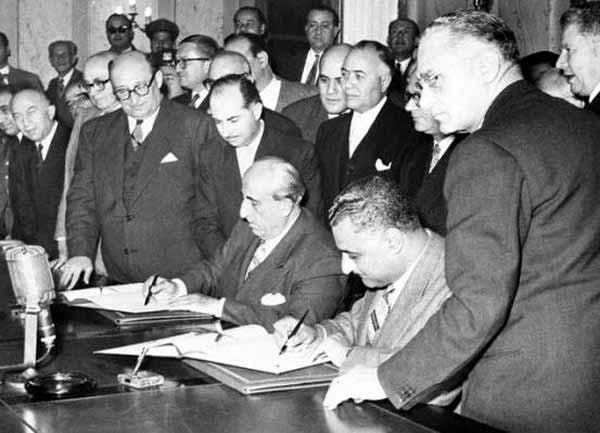
Gamal Abd al-Nasser at the gates of the Presidential Palace in Damascus in 1958, The Online Museum of Syrian History, public domain
United Arab Republic
In this article, we shall discuss the formation and then breakup of the United Arab Republic. We shall examine the makeup of the UAR by examining the geopolitics of the Middle East, domestic politics within Egypt and Syria, as well as international relations between the two states, and other countries in the region.
Ideological Underpinnings of the United Arab Republic
In order to understand the formation of the United Arab Republic, it is critical to understand the ideological and political foundations of the Egyptian leader at the time, Gamal Abdel Nasser. Nasser was a strong advocate of Arab nationalism and Arab unity. Nasser’s message was one of highlighting Arab unity and culture, focusing less on Western culture, but rather, showing that Arab history had offered significant contributions to the world. Thus, it was important for Nasser to highlight Arab identity in Egypt and the Middle East. Thus, for example, in 1956, Nasser, the Revolutionary Command Council and the Free Officers wrote into the Egyptian constitution that Egypt was an Arab state. In addition, Nasser became an active leader in international relations, working with other Arab leaders with regards to regional cooperation, as well as “interfer[ing] in the political affairs of other Arab countries” (Cleveland & Bunton, 2013: 292).
Thus, the idea of a unified Arab state was something that enticed Nasser, and that seemed to be along the lines of his message of Arab unity and Arab Nationalism. Thus, “[t]he creation of the United Arab Republic (UAR) in early 1958 appeared to be a major step along the road to Arab unity. The UAR was a total union of Syria and Egypt into a single state” (Cleveland & Bunton, 2013: 292).

Gamal Abdel-Nasser and Shukri al-Quwatli signing the Syria-Egypt union pact. Behind Quwatli stands Abdullah al-Khani, the secretary-general of the Presidential Palace, and to his right is Prime Minister Sabri al-Asali and to al-Asali’s right is Khalid al-Azm, 2 February 1958, Syrian History, public domain
Formation of the United Arab Republic
The reason for the United Arab Republic was not only because of Nasser’s emphasis on pan-Arab unity, but it also came about as a result of domestic political developments in Syria. Having elected anti-French leaders in the 1940s, the Ba’th Party who was in power in the late 1950s was concerned about a Communist political movement in the country possibly taking them out of power. Thus, by asking Nasser to joint with Syria as the United Arab Republic, they hoped to stop the communist influence, and all the while, keep their own influence, and be able to stay in power. Shortly after, the United Arab Republic was announced (Cleveland & Bunton, 2013: 292).
However, the creation of this new United Arab Republic was not a smooth transition between Egypt and Syria. Part of this was because of the domestic turmoil within Syria itself. They seemed to feel but little choice in making this political union with Egypt. And Nasser, who was a strong advocate of Arab unity, saw this as a great example of his ideas put into practice, and could not turn down what the Syrian leaders were proposing (Cleveland & Bunton, 2013: 292).
However, as the UAR developed, it becomes clear that the Syrian leadership would not having primary, or equal control of the state. In fact, “Egypt quickly became dominant.” The Syrian leaders who had requested the merger found themselves forced to live in Cairo, from where they exercised little influence on events in their homeland. Nasser, who became the first president of the UAR, simply imposed on Syria the single-party military regime that had worked so well in Egypt. Egyptian military and civilian personnel streamed into Syria, replacing their Syrian counterparts in several important functions…” (Cleveland & Bunton, 2013: 292).
End of the United Arab Republic
In September of 1961, the Syrian leadership officially ended the United Arab Republic with Nasser and Egypt. There are many factors that may have had some part in the ending of the union between Egypt and Syria.
According to scholars,
“[o]ne unforeseen result of the new Arab socialist laws in Egypt [(which included the July 1961 laws implemented by Nasser’s government)] was Syria’s secession from the United Arab Republic in late September 1961. Many explanations have been given for this breakaway: intrigues by other Arab regimes (especially Jordan) or by foreign powers, the low salaries paid [to] UAR government officials and military officers relative to what Syrians had been used to getting, Syrian resentment over the imperial attitudes of many Egyptians working in Syria (especially their chief Abd al-Hakim Amir, who was Nasir’s right hand man), several years of poor harvests (hence higher food prices), and disillusionment with Arab nationalism once it became clear that Iraq and other oil-rich countries would not join the United Arab Republic” (Goldschmidt, 2004: 137).
For example, by Nasser eliminated Syrian political parties, this upset many political elites in the country. In addition, his land redistribution also upset those powerful landowner families in the country (Cleveland & Bunton, 2013: 292).
But while this hurt Nasser’s reputation as trying to keep a unified Arab state, something he advocated for in his pan-Arab philosophy, he nonetheless continued to argue for the importance of Arab nationalism, and was still active in the domestic politics of other states in the region, even if some of the actions (such as his support of the military overthrow in Yemen in 1962) caused tension between Egypt and the Saudi Arabian leadership, for example (Cleveland & Bunton, 2013: 292-293).
References
Cleveland, W.L. & Bunton, M. (2013). A History of the Modern Middle East. Boulder, Colorado: Westview Press.
Goldschmidt Jr., A. (2004). Modern Egypt: The Formation of a Nation State, Second Edition. Boulder Colorado, Westview Press.


